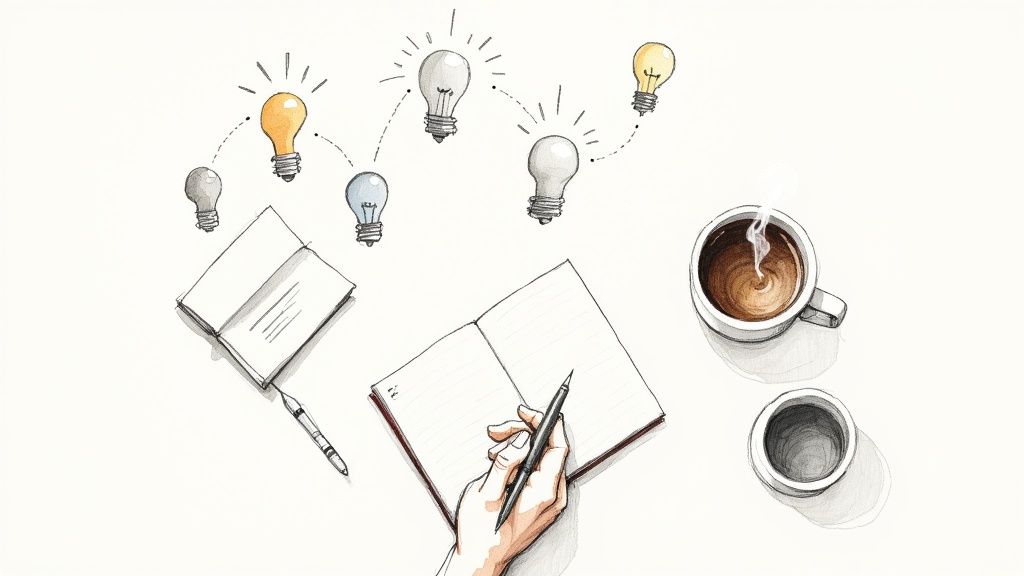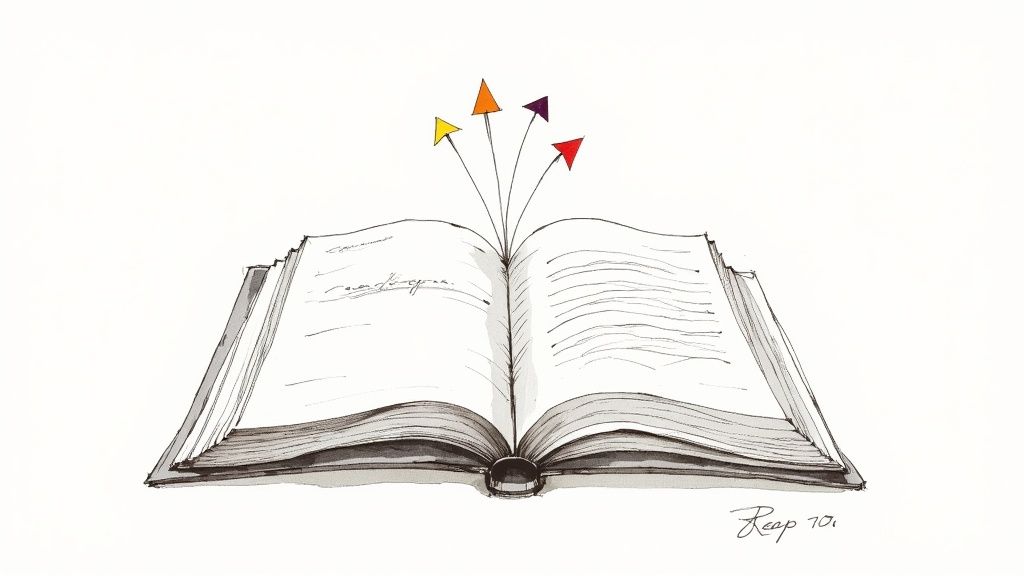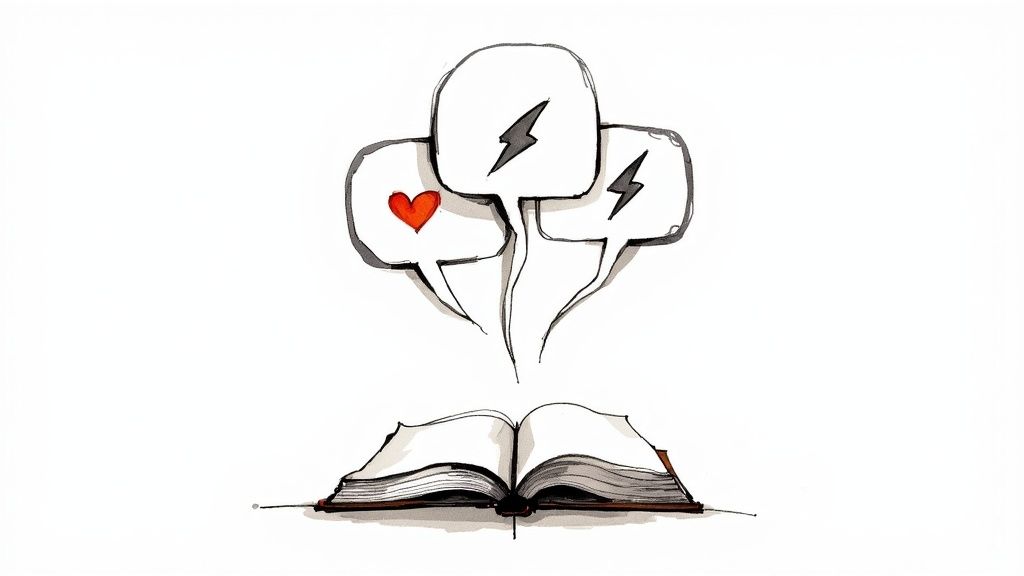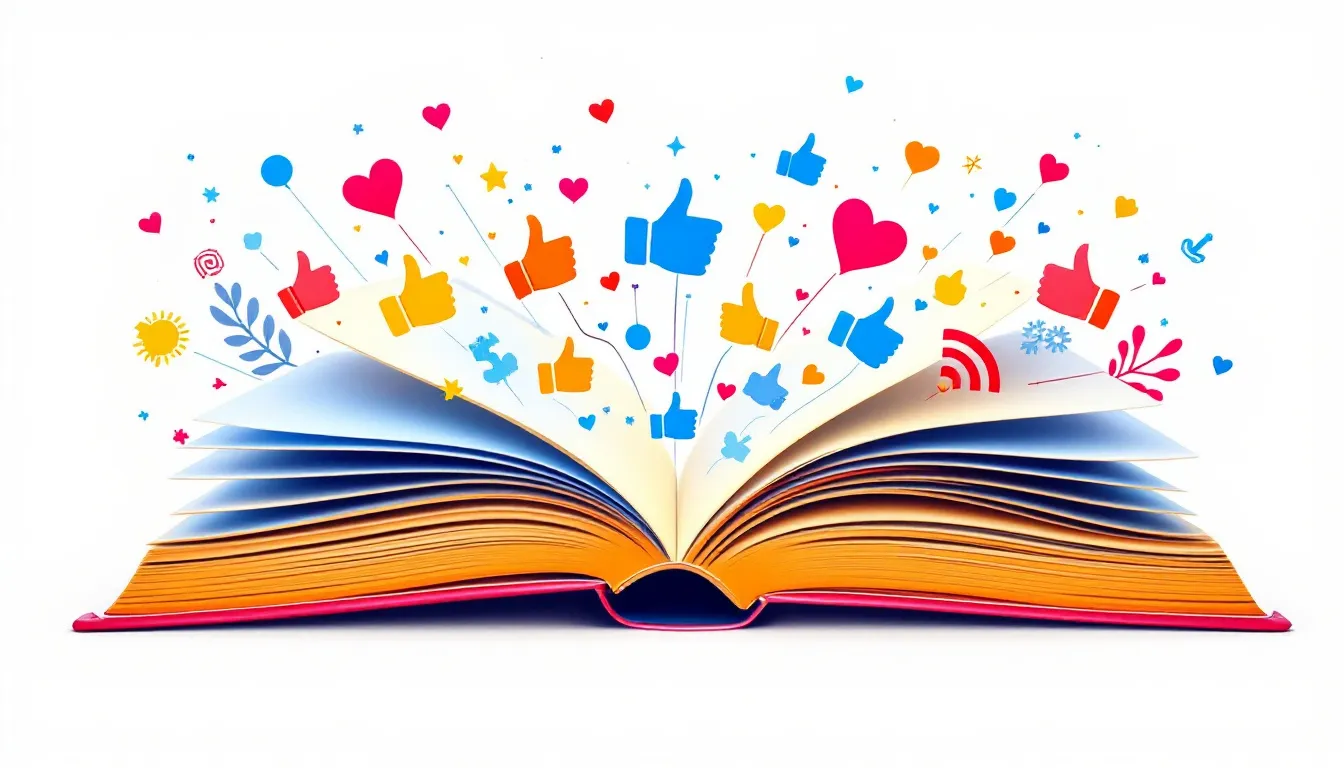How to Write a Book Blurb That Sells: Complete 2025 Guide

Quick Answer
How do you write a book blurb that sells in 2025?
An effective book blurb follows a proven 3-part structure: Hook (grab attention instantly), Conflict (introduce protagonist and stakes), and Tease (end with compelling question). Keep it 100-150 words, focus on emotional connection over plot summary, and match the tone to your genre. The goal is to create urgency and curiosity, not explain the entire story.
3-step blurb writing framework:
- The Hook - One shocking/intriguing sentence that stops the scroll
- The Conflict - Show what protagonist wants and what's in their way (2-3 paragraphs max)
- The Tease - End with a question or impossible choice that creates urgency
For real-world examples, see our 6 blurb styles or 8 proven formulas.
So you've poured your heart and soul into writing a book. Now comes the hard part: convincing someone to actually read it. To do that, you need to master the art of the book blurb—that short, punchy sales pitch on the back cover or in the online description.
Think of it as your story's 150-word audition. Get it right, and you turn a casual browser into a paying reader. Get it wrong, and they just keep scrolling. A killer blurb boils down to three key ingredients: an irresistible hook, a clear conflict, and a final tease that makes the reader desperate for more.
Why Your Blurb Is Your Most Critical Sales Tool
Your book blurb is more than just a summary; it's a high-stakes advertisement for the world you've created. After your cover catches their eye, the blurb is what reels them in. It has one job: to forge an instant connection and convince someone that your book is the experience they've been looking for.
A great blurb doesn't just explain the plot. It sells a feeling. It promises mystery, heartbreak, or adventure. It's your one chance to whisper directly to your perfect reader, "This story is for you."
Standing Out in a Sea of Books
The pressure to write a compelling blurb has never been higher. With the global book market valued at a staggering $150.99 billion in 2024, you’re not just competing with a few other books; you’re up against millions. You can find more details on this competitive landscape over at GrandViewResearch.com. In this crowded arena, a weak blurb is a death sentence.
A blurb is NOT a summary or a synopsis. It’s its own unique piece of writing. A book blurb needs to have its own narrative arc that’s different from the narrative arc of your book.
This is the single most important concept to grasp. You aren't retelling the story; you're building tension and stoking curiosity. The blurb needs to feel urgent and exciting, pushing the reader to open the book and find out what happens.
Before we get into the nitty-gritty of how to write one, let's look at the core components that make a blurb work. Each part has a specific job to do, and understanding these roles is the first step to crafting a description that sells.
Core Components of a Killer Book Blurb
| Component | Purpose | What It Achieves |
|---|---|---|
| The Hook | Grab the reader's attention instantly. | Introduces the main character and their world with a compelling opening that makes them stop and read on. |
| The Conflict | Introduce the central problem or inciting incident. | Establishes the stakes. It shows what the character stands to lose and why the reader should care. |
| The Tease | Create suspense and leave the reader wanting more. | Poses a lingering question or a high-stakes choice, compelling the reader to buy the book to find the answer. |
These three pieces work together to create a tiny, powerful narrative that does the heavy lifting for you.
What Your Blurb Absolutely Must Accomplish
To really appreciate its power, let's break down the blurb's job into a simple checklist. In just a few sentences, it has to:
- Grab a reader mid-scroll. Your opening line is everything.
- Show what’s at stake. What does the hero have to gain or lose?
- Hint at the genre. The tone and word choice should instantly signal whether it's a thriller, romance, or epic fantasy.
- Create a burning question. Leave the reader with an itch that only turning the pages can scratch.
The Anatomy of a Blurb That Sells
Alright, let's stop talking theory and get our hands dirty. There's a practical framework I've seen work time and again for authors, regardless of their genre. Think of your blurb not just as a summary, but as a mini-story designed to sell your main story. It follows a simple, three-act structure.
Once you get this down, you can finally stop staring at that blinking cursor and start writing a description that actually hooks readers. It’s all about building momentum and forging an emotional connection in just a few powerful lines.
This infographic really nails the essential flow, from that first grabby hook to the final, lingering tease.
As you can see, each part builds on the one before it. The goal is to guide a potential reader from mild curiosity to an urgent need to know what happens next.
Part 1: The Hook
The hook is your first—and honestly, often your only—chance to stop a reader mid-scroll. It's a single, sharp sentence that’s all about provoking curiosity. This is absolutely not the place for long-winded descriptions or complicated world-building. You need to be striking and immediate.
A great hook often throws a shocking statement, a deep question, or a really unusual situation at the reader. So instead of a flat "A detective investigates a strange case," you might try something like, "The first victim was found with a single raven's feather in his hand. The second had two." See the difference?
Part 2: The Core Conflict
Now that you have their attention, it's time to introduce the core conflict. This is where you reveal your protagonist, what they desperately want, and the massive obstacle standing in their way. Keep this part tight—no more than two or three concise paragraphs.
Here’s what you need to hit:
- The Protagonist: Introduce your main character in a way that makes them feel real and relatable.
- The Goal: What is their primary motivation? What do they want more than anything?
- The Obstacle: Who or what is stopping them from getting it?
Don't get lost in the weeds with subplots or a laundry list of character names. Clarity is everything here. A reader must quickly grasp who the story is about and what's at stake. This is the heart of your blurb, the part that makes someone genuinely care about the outcome. For a deeper dive, check out our complete guide with real blurb examples.
Part 3: The Final Tease
The last piece of the puzzle is the tease—what I like to call the "mic drop." It’s a cliffhanger or a profound question that leaves the reader hanging, creating that final push that gets them to click "buy now." It hints at the tough choices or dire consequences ahead without ever revealing the resolution.
The goal of the tease is to turn the blurb’s conflict into an urgent, personal question for the reader: "What would I do in that situation?"
At its core, learning how to write a book blurb is about mastering persuasive storytelling. It is a form of marketing, after all. For more inspiration, you can find some fantastic storytelling in marketing examples that show just how powerful a well-told narrative can be. By ending on a high-stakes choice or an impossible dilemma, you make your book completely irresistible.
Crafting a Hook That Stops the Scroll

Let's be honest. Your opening sentence isn't just the beginning of your blurb—it’s a high-stakes audition. In the world of endless online scrolling, this single line has to act like a powerful magnet, forcing a potential reader to slam on the brakes and give your book a real look.
This first sentence, your hook, shoulders the entire burden of a reader's first impression. It’s not about neatly summarizing your plot. It's about sparking an immediate emotional reaction: curiosity, a jolt of shock, or a deep sense of intrigue. Think of it as clickbait that actually delivers on its promise.
Exploring Powerful Hook Types
Not all hooks work the same way, and finding the right one means matching it to your book's specific genre and tone. The goal is to pick an angle that feels completely authentic to your story while being nearly impossible for a reader to ignore.
Here are a few proven hook archetypes I've seen work wonders:
The Shocking Statement: This type of hook smacks the reader with an unexpected or provocative truth from your story's world. A classic example is the blurb for The Martian by Andy Weir: "Six days ago, astronaut Mark Watney became one of the first people to walk on Mars. Now, he's sure he'll be the first person to die there." It’s an instant gut-punch.
The Atmospheric Opener: This hook uses vivid, evocative language to plunge the reader directly into your story’s setting or mood. It sells a feeling, not a plot point. Imagine something like: "The house stood on a bleak point of land, its windows staring out at the sea like vacant eyes." You're there.
The Character-Driven Dilemma: This approach introduces your main character and their central problem in one compelling breath. For example, the blurb for The Seven Husbands of Evelyn Hugo does this masterfully: "Evelyn Hugo, the reclusive Hollywood legend, is finally ready to tell the truth about her glamorous and scandalous life. But when she chooses unknown magazine reporter Monique Grant for the job, no one is more astounded than Monique herself."
The very best hooks create a question in the reader's mind without ever explicitly asking one. They present a puzzle so compelling that the reader feels an urgent need to solve it—first by reading the blurb, and then by buying your book.
The Do's and Don'ts of Opening Lines
Writing the perfect hook is more than just choosing a style; it demands meticulous word choice and a sharp eye for avoiding common pitfalls. The line between intriguing and cliché can be razor-thin. To learn how to create openings that truly pop, you might want to explore these 7 essential tips to craft viral book hooks.
Ultimately, a powerful hook comes down to sharp, active language. For some excellent advice on this, check out these tips to enhance writing for clarity and impact. By focusing on precision and energy, you’ll craft an opener that is both memorable and incredibly effective at making readers stop and pay attention.
Tailoring Your Blurb to Genre Expectations

A blurb that tries to please everyone will end up impressing no one. It's a hard truth. The only way to grab your ideal reader is to speak their language, and that means knowing and delivering on the promises of your genre. Writing a blurb isn't a one-size-fits-all job; it’s about crafting targeted copy that resonates.
Think about it: a thriller reader's expectations are a world away from someone picking up a historical romance. One craves adrenaline and suspense, the other is searching for simmering tension and deep emotional connection. Your blurb’s tone, structure, and focus must align perfectly with those expectations if you want to turn a curious browser into a buyer.
Mystery and Thriller Blurbs
For a mystery or thriller, your blurb needs to be a masterclass in suspense. Your job is to set up a tantalizing puzzle and hint at the lurking danger without giving the game away. This is where you introduce that core mystery—the bizarre crime, the vanished person, the chilling threat—and make it crystal clear what’s at stake for your hero.
Focus on these elements:
- An Unsettling Hook: Kick things off with the crime itself or the precise moment everything goes sideways.
- The Protagonist’s Predicament: Introduce your investigator or victim and show us their personal connection to the case. Why them?
- Escalating Stakes: Drop hints that the clock is ticking or that the threat is far more sinister than anyone suspects.
A weak mystery blurb just lists facts. A great one poses a question the reader can't leave unanswered, like, "Can she find the truth before she becomes the next victim?"
A generic blurb is a failed blurb. It's not enough to say a detective solves a crime. You have to show the reader why this crime is different, why this detective is the only one who can solve it, and what they stand to lose if they fail.
Mystery is the most popular genre in North America, with romance and fantasy right behind it. That means the competition is fierce. Your blurb has to be razor-sharp to even get noticed.
Romance Blurbs
When you're writing a romance blurb, the focus shifts entirely from external action to internal emotion. Readers are here for the chemistry, the dynamic between your leads, and the emotional rollercoaster. Your blurb’s sole purpose is to sell that central relationship conflict.
Here’s a simple, effective approach:
- Introduce Character A: Present your first lead and their current world or mindset.
- Introduce Character B: Show how the second lead crashes into Character A's world, disrupting everything.
- Reveal the Core Conflict: This is the magic. Explain exactly why these two can't—or at least shouldn't—be together. This is the heart of the "will they, won't they?" tension that readers live for.
Your goal is to spotlight the central trope—whether it's enemies-to-lovers, fake dating, or second chances—and promise readers the emotional payoff they're looking for. To really hit the mark, you have to know your audience inside and out, which starts with understanding your target audience through competitive analysis.
Fantasy and Sci-Fi Blurbs
With speculative fiction, your blurb has to pull double duty: it needs to sell the story and the world. But be careful. The most common mistake I see is writers front-loading their blurbs with dense lore and unpronounceable names. A reader doesn't need your world’s entire history upfront; they just need a character to care about.
Ground the reader by focusing on the protagonist's relatable problem, just one that happens to be in an extraordinary setting. And as you build your author platform, remember that developing a consistent brand voice is just as crucial. It helps fans recognize your work instantly, whether you're writing an epic fantasy or a gritty space opera.
Polishing Your Blurb: Advanced Tactics and Common Pitfalls
Once you have the basic framework down, it's time to add the final polish. This is where you move beyond a simple description and start using proven techniques that can turn a hesitant browser into an eager buyer.
Think of these strategies as the secret sauce that makes a good blurb truly great—the kind that works overtime selling your book on crowded digital shelves.
Fine-Tuning for Digital Storefronts
Your blurb doesn't just live on the back of a physical book anymore. It’s a vital sales tool on digital storefronts like Amazon's Kindle Store or Kobo. That environment demands a different approach. The explosion in self-publishing means your book is competing for clicks, and a sharp, concise blurb is non-negotiable. For a deeper look at industry trends, check out this report on the book publishing market.
This is where you need to think like a reader searching for their next favorite book. What words would they use? Sprinkle in relevant keywords and genre-specific tropes that your ideal audience will recognize instantly. If you've written a "cozy fantasy," for example, using phrases like "low-stakes magic" or "found family" can act as a powerful signal to the right readers.
Pro Tip from the Trenches: Those first 20-30 words are gold. Most online stores, especially on mobile, chop off the rest behind a "read more" link. Your hook has to be right at the top, powerful enough to stop the scroll cold.
The Power of Social Proof: Comps and Quotes
Nothing builds trust faster than a recommendation. You can create this effect right in your blurb by using comparative titles and standout quotes.
- Comparative Titles: Using a phrase like "Perfect for fans of The Martian and Project Hail Mary" is a brilliant shortcut. It instantly tells the reader about your book's tone and subject matter, helping them make a quick, confident decision.
- Powerful Quotes: A punchy, one-sentence review from a well-known author, a popular book blogger, or a trade publication can be more convincing than anything you could ever write about your own work. Don't bury it—place it right at the top for maximum impact.
Blurb Clinic: Common Mistakes to Avoid
I see the same handful of blunders trip up authors time and time again. These subtle mistakes can quietly sabotage your sales without you ever knowing why. Here are the biggest offenders and how to fix them.
Mistake 1: Giving Away the Whole Story Your blurb is a hook, not a book report. If you reveal the big twist or spoil the ending, you’ve just given the reader a perfect reason not to buy your book.
- Before: "After discovering the CEO is her long-lost father, she must team up with him to take down his rival, ultimately exposing the conspiracy and saving the company."
- After: "She came to destroy a ruthless CEO, but a shocking family secret forces her into an uneasy alliance. To save the company, she may have to trust the one man she swore to ruin."
See the difference? The second version is all about tension and unanswered questions.
Mistake 2: A Dizzying Cast of Characters A potential reader has no emotional investment in characters they haven't met yet. Bombarding them with a list of unfamiliar names like Kaelen, Lyra, and Fenrir is just confusing.
- Before: "When Kaelen, Lyra, and Fenrir discover the Shadow Orb, they must take it to Lord Elara in the city of Aerthos before the evil sorcerer Malakor can seize it."
- After: "A down-on-his-luck thief, a disgraced knight, and a runaway princess are all that stand between a world-ending artifact and the sorcerer hell-bent on claiming it."
The second example uses archetypes. It's clean, evocative, and lets the reader immediately grasp the stakes without needing a character sheet.
Answering Your Toughest Blurb Questions
Even with the best templates in hand, a few tricky questions always seem to pop up right when you sit down to write. I get it. The theory is one thing, but putting it into practice is another. Over the years, I've heard the same questions from authors time and again, so let's tackle them head-on.
Here are some direct answers to clear up that confusion, helping you move forward with confidence and craft a blurb that truly sells.
How Long Should a Book Blurb Be?
Aim for the sweet spot: 100 to 150 words. That's enough real estate to introduce your world and raise the stakes, but concise enough to be scanned quickly on a back cover or an online product page. Go much longer, and you'll see readers' eyes glaze over.
For online retailers like Amazon, remember that only the first 20-30 words are visible before a potential reader has to click "read more." This means your hook can't just be good; it has to be front-loaded. This constraint is actually a blessing in disguise—it forces you to be sharp and powerful right from the start.
Should I Use a Question in My Blurb?
Yes, but with a bit of finesse. A well-placed question can be an incredible tool for building intrigue. It works like a mini-cliffhanger, creating an itch that the reader feels they just have to scratch by buying your book.
Something like, "Can she uncover the conspiracy before she becomes its next victim?" pulls a reader in much more effectively than a flat statement. The key is to make the question specific to your plot's central conflict. Avoid vague, generic questions that could apply to any book.
Expert Tip: While a question can make for a great hook within the blurb, I generally advise against ending with one. Top-tier blurbs often rephrase that final question into a powerful, declarative statement. It creates a much stronger, more confident "mic drop" moment.
Should I Include Spoilers in the Blurb?
Absolutely not. This is probably the biggest mistake I see new authors make. Your blurb's job is to entice, not to give away the farm. You're setting up the initial conflict and teasing the stakes, but revealing a major plot twist or, even worse, the ending is the fastest way to lose a sale. Why would they buy the book if you've already told them what happens?
Think of your blurb as a movie trailer. It shows you the premise, introduces the main problem, and hints at the action, but it saves the big reveals for the theater. Guard your story's secrets—they're your most valuable asset.
How Many Characters Should I Name?
My advice is to keep it simple: focus on your protagonist. At most, you might mention one other key character, like the primary antagonist or love interest.
Loading up your blurb with multiple names just creates confusion. The reader has zero emotional connection to these names yet, so they become clutter, making the blurb harder to read and absorb. Stick to the hero, their core motivation, and the main obstacle standing in their way. Readers will have plenty of time to meet your full cast of characters once they start turning the pages.
Feeling bogged down by the thought of writing blurbs, picking keywords, and creating ad copy? ManuscriptReport's comprehensive analysis service can take your finished manuscript and generate a full, launch-ready marketing kit in minutes—including multiple blurb variations optimized for your genre. For complete marketing support, explore our affordable book marketing services designed to save you time while maximizing sales.
Explore More Blurb Resources:
- See real-world style examples: 6 Book Blurb Examples
- Learn advanced formulas: 8 Book Description Examples
Related Articles

The Ultimate Affordable Book Launch Checklist: 9 Essential Steps for 2025
Complete affordable book launch checklist for 2025. Follow 9 proven steps—from budget planning to post-launch—for indie and self-published authors. Launch successfully for under $500.

How to Write Viral Book Hooks: 10 Proven Strategies for Social Media Success
Master the art of viral book hooks with 10 proven strategies, platform-specific tactics, and templates that grab attention on BookTok, Instagram, and beyond.

7 Must-Have AI Writing Tools for Authors
Discover essential AI writing tools for authors to boost creativity and streamline marketing. Learn actionable tips and explore solutions like ManuscriptReport.com.